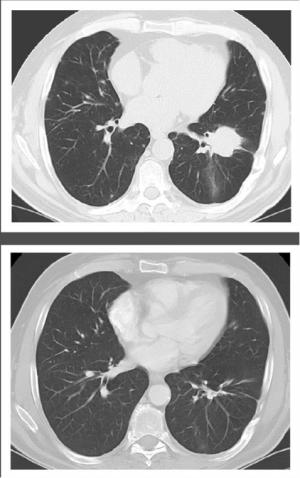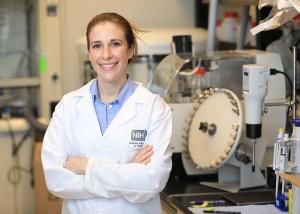Breakthrough Research
A Showcase of 2023 NIH Scientific and Clinical Discoveries
Clinical and scientific breakthrough research presentations have become an end-of-year NIH Office of Intramural Research celebration.
On Dec. 20, 2023, the scientific directors and clinical directors from each institute and center (IC) had three minutes and one slide to present a standout intramural research accomplishment from the past year. We highlight here some of our favorites.
NIA—presented by Luigi Ferrucci:
Blood–brain barrier endothelial cells express proteins that can be used as plasma biomarkers to identify neurological conditions (Stroke 54:2853-2863, 2023). These biomarkers at midlife can predict a 25-year risk of dementia and Alzheimer’s disease (Sci Transl Med 15:eadf5681, 2023).
PI: Keenan Walker, investigator in the NIA Multimodal Imaging of Neurodegenerative Disease Unit
NCI-CCR—presented by Glenn Merlino:

CREDIT: NCI-CCR
The image on the top shows an area of cancer infiltration pre-treatment, and on the bottom is the same area after three months of treatment.
A 30-year clinical trial at the CC showed how an immunotherapy protocol increased survival by 20 years for people with a low-grade form of lymphomatoid granulomatosis, leading to a new standard of treatment. Conversely, individuals who developed the higher-grade form of the same cancer responded better to a chemotherapy regimen. Lymphomatoid granulomatosis is a rare Epstein-Barr virus-associated B-cell lymphoproliferative disorder with a median overall survival of less than two years (Lancet Haematol 10:e346-e358, 2023).
PI: Wyndham Wilson, senior investigator in the NCI-CCR Lymphoid Malignancies Branch
NCI-DCEG—presented by Stephen Chanock:

CREDIT: NCI
Meredith Shiels
NIH researchers and collaborators estimated trends in U.S. cancer mortality between 2000–2019 for the six leading types of cancers: lung, colorectal, pancreas, breast, prostate, and liver; as well as all other cancers (Cancer Discov 13:1084-1099, 2023). Age-standardized cancer mortality rates declined 2.3% per year over that time period, but that rate will need to increase to a 2.7% decrease per year to reach the Cancer Moonshot Initiative’s goal to reduce age-standardized cancer mortality rates by at least 50% over the next 25 years. The study identified the most promising and realistic opportunities to increase those percentages.
Relatedly, NIH Director Monica Bertagnolli published a commentary that accompanies the research article (Cancer Discov 13:1049-1052, 2023).
PI: Meredith Shiels, senior investigator in the NCI-DCEG Infections and Immunoepidemiology Branch
NHLBI—presented by Rick Childs:
The SESAME, or septal scoring along midline endocardium method, is a new transcatheter electrosurgery technique to treat hypertrophic cardiomyopathy. First tested in animals (Circ Cardiovasc Interv 15:e011686, 2022), and then humans (Circ Cardiovasc Interv 15:e012106, 2022) by cardiologists at Emory University (Atlanta), SESAME replaces open-heart surgery with a less invasive transcatheter electrosurgery that allows a cardiologist to navigate guidewires through the septal myocardium to accomplish longitudinal slicing (myotomy) of the heart muscle. The new technique might have implications for other types of nonsurgical heart procedures in the future.
PI: Robert Lederman, senior investigator of the NHLBI Cardiovascular Intervention Laboratory
CREDIT: NHLBI
A video of SESAME in action.
NIBIB—presented by Richard Leapman:

CREDIT: NIBIB
Kaitlyn Sadtler
Bioscaffolds regulate healing and tissue regeneration after injury better than synthetic devices by co-opting healing pathways also used by tumors to avoid destructive autoinflammation (Nat Mater DOI:10.1038/s41563-023-01689-9, 2023). These biomaterials could one day be used for regenerative medicine immunotherapies and therapeutic wound-healing vaccines.
PI: Kaitlyn Sadtler, Stadtman investigator in the NIBIB Section on Immunoengineering
NIH CC—presented by Leighton Chan:
A powered knee exoskeleton developed to treat children with cerebral palsy who have crouch gait (Front Robot AI 8:702137, 2021) has entered an interventional trial. The robotic exoskeleton was developed by Thomas Bulea, an investigator in the NIH CC Neurorehabilitation and Biomechanics Section of the Rehabilitation Medicine Department.
Other scientific discoveries include the following:
NCATS: FDA approves a new drug to treat Duchenne muscular dystrophy that potentially delays disease progression by two years (JAMA Neurol 79:1005-1014, 2022).
NCCIH: Video-based acute pain assessment is subject to sociocultural biases showing that perceivers attributed more pain to women than men and less pain to Black individuals than white individuals (Affect Sci 4:350-369, 2023).
NEI: Analyzing retinal images with AI predicts age-related macular degeneration (Mach Learn Med Imaging 13583:11-20, 2022).
NHGRI: Researchers discovered a gene that enables yeast to defend against a toxin (Proc Natl Acad Sci 120:e2217194120, 2023).
NIAAA: In a mouse model, researchers demonstrated how endocannabinoid receptors mediate communication between the brain’s cortex and amygdala, which may have implications for understanding post-traumatic stress syndrome as well as cannabis- and alcohol-use disorders (Neuron 111:3053-3067.e10, 2023).
NIAID-VRC: A vaccine boost via a mist to the mucosa of the nose or an aerosol to the lungs elicits strong, durable immunity associated with a rapid suppression of SARS-CoV-2 replication in the nose or lungs five months later (bioRxiv, DOI:10.1101/2023.11.06.565765).
NIAID: Scientists from NIAID, NIDCR, NIDDK, and NHLBI discovered an important role of the immune system's complement system in driving the immune response to a systemic fungal infection (Cell 186:2802-2822.e22, 2023).
NIAMS: Gain or loss of function in the gene PLCG2 is related to a broad range of immune disorders with distinct clinical presentations, suggesting the importance of developing new gene-editing therapies (J Allergy Clin Immunol, DOI:10.1016/j.jaci.2023.08.036, 2023).
NICHD: A new online resource, Daniocell, presents single-cell gene-expression data during zebrafish (Danio rerio) development that can be used to understand human development (Dev Cell 58:3028-3047.e12, 2023).
NIDA: A new bivalent drug to treat opioid-use disorder has been developed (J Med Chem 66:10304-10341, 2023).
NIDCD: Researchers developed a gene-therapy strategy to treat Usher syndrome 1B (Mol Ther Methods Clin Dev 30:534-545, 2023).
NIDCR: A cytoskeletal signaling pathway during very early human organ development was discovered that coordinates brain and craniofacial development (Nat Commun 14:4499, 2023).
NIDDK: Scientists using a multi-omics approach analyzed the gut-liver axis and revealed metabolic dysregulation in the progression of hepatitis C infection to cirrhosis (Nat Microbiol 8:12-27, 2023).
NIEHS-DTT: The NIEHS Division of Translational Toxicology engaged with federal, academic, and community partners to respond to the chemical exposures related to the East Palestine, Ohio, train derailment.
NIEHS: Congenital arhinia (absence of the nose) and a muscular dystrophy called FSHD2 are both caused by mutations in the same gene, suggesting an environmental modifier in these conditions. (Sci Adv 9:eabq7744, 2023).
NIMH: Magnetic seizure therapy has fewer side effects and was as effective as electroconvulsive therapy for treatment-resistant depression (JAMA Psychiatry, DOI:10.1001/jamapsychiatry.2023.4599).
NIMHD: Vicarious experience of discrimination is as impactful as direct experience of discrimination on psychological stress (Am J Prev Med 65:439-447, 2023).
NINDS: A new structural model of an ion channel shows its role in transmitting electrical signals in the brain, revealing insights into neurodevelopmental disorders (Nature 622:410-417, 2023).
NLM: An AI approach to analyzing genetic variants associated with type 2 diabetes found four times as many associated variants as other traditional approaches. (Proc Natl Acad Sci 120:e2206612120, 2023).
Keep an eye out for the NIH Catalyst throughout 2024 to learn more about these and so many other new discoveries happening every day at NIH.
This page was last updated on Saturday, January 18, 2025
